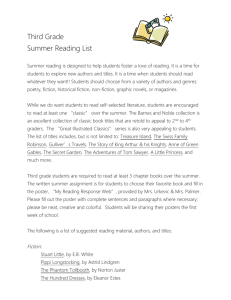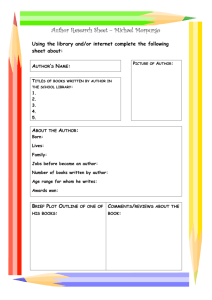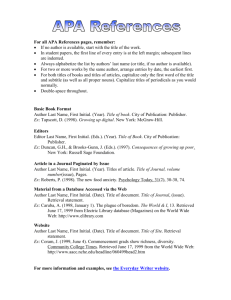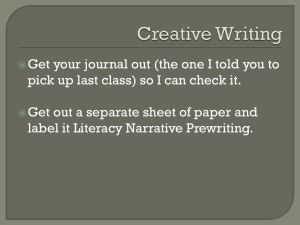Libr 285_Data Analysis - Melissa Eleftherion Carr
advertisement
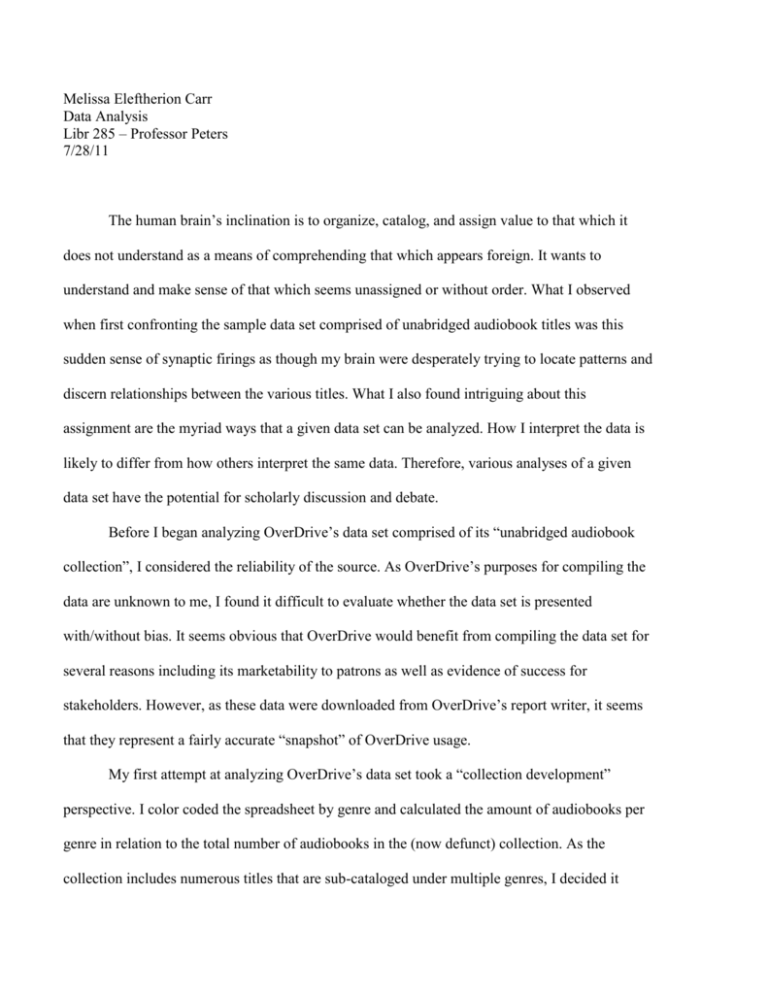
Melissa Eleftherion Carr Data Analysis Libr 285 – Professor Peters 7/28/11 The human brain’s inclination is to organize, catalog, and assign value to that which it does not understand as a means of comprehending that which appears foreign. It wants to understand and make sense of that which seems unassigned or without order. What I observed when first confronting the sample data set comprised of unabridged audiobook titles was this sudden sense of synaptic firings as though my brain were desperately trying to locate patterns and discern relationships between the various titles. What I also found intriguing about this assignment are the myriad ways that a given data set can be analyzed. How I interpret the data is likely to differ from how others interpret the same data. Therefore, various analyses of a given data set have the potential for scholarly discussion and debate. Before I began analyzing OverDrive’s data set comprised of its “unabridged audiobook collection”, I considered the reliability of the source. As OverDrive’s purposes for compiling the data are unknown to me, I found it difficult to evaluate whether the data set is presented with/without bias. It seems obvious that OverDrive would benefit from compiling the data set for several reasons including its marketability to patrons as well as evidence of success for stakeholders. However, as these data were downloaded from OverDrive’s report writer, it seems that they represent a fairly accurate “snapshot” of OverDrive usage. My first attempt at analyzing OverDrive’s data set took a “collection development” perspective. I color coded the spreadsheet by genre and calculated the amount of audiobooks per genre in relation to the total number of audiobooks in the (now defunct) collection. As the collection includes numerous titles that are sub-cataloged under multiple genres, I decided it would be fair to only include each title once to directly correspond to the total. Following is a graph (Figure 1) to visually represent that data: Figure 1: Unabridged Audiobook Collection by Genre QuickTime™ and a decompressor are needed to see this picture. The entire collection is comprised of 3318 titles and 33 genres. With 2248 titles, the fiction genre alone comprises more than half of the total collection. While these amounts are notable and technically accurate, there is one caveat: “fiction” includes many sub-categories that I have not listed in order to reconcile the total number of genre titles with the total titles in the collection. This analysis appears to present limitations in terms of accuracy because several of the excluded fiction sub-categories contained a substantial number of titles. In particular, “mystery”, “science fiction and fantasy”, and “suspense” all contributed significantly to the total amount of fiction titles. My decision to analyze the data in this way also affected the total number of titles in several genres. Namely, “nonfiction”, “historical fiction” and “juvenile fiction” comprise greater amounts than are pictured in Figure 1. Again, the choice to exclude these titles was due to their primary cataloging status as “fiction.” Second to “fiction”, the “unassigned” genre totaled 208 titles. Clearly, a huge gap exists between these two categories. At the opposite end of the spectrum, “children’s literature”, “cooking”, “ethics”, “gender studies”, “geography”, “law” and “multicultural” all list a single title in each respective genre. As is evidenced in Figure 1, distinctions between those categories with one or two titles are not discernible in the graph. For a more detailed analysis of the calculated totals, see attached spreadsheets (collection development by genre; poetry usage) Several categories in the audiobook collection do not seem especially given to the audiobook medium which may explain their poor contributions to the collection. Namely, “arts and antiquarian” seems more inclined toward the visual rather than aural representations. However, there are two categories worth mentioning that OverDrive may choose to augment due to their predilection toward the aural: “children’s literature” (currently comprising one title) and “poetry” (currently comprising seven titles). Since “children’s literature” only comprises one title in the collection, I chose to only evaluate the number of poetry titles in the collection, which was done in relation to poetry’s average number of checkouts. Figure 2. Poetry Audiobook Usage There were a total of 135 poetry checkouts between 9/15/05 – 12/7/06 and the average number of said checkouts was 19.285714. As can be seen in Figure 2, Alexander Scourby’s 81 Famous Poems was checked out 34 times beating out William Shakespeare’s Complete Sonnets with 25 checkouts. There were 129,000 total checkouts for the entire audiobook collection of 3318 titles. The average number of total checkouts was 38.87. In relation to the number of total audiobook checkouts for the collection, the total number of poetry checkouts seems above average for a mere seven titles. Therefore, it seems advisable for OverDrive to augment their poetry collection, as the user base seems to exist. Analyzing data sets is a painstaking and iterative process that demands accuracy and patience. This assignment allowed me a glimpse of the inherent challenges and tepid outcomes of evaluating data, which gave me a greater appreciation for statisticians and left-brained individuals. References OverDrive. (2010, December 31). Unabridged audiobook titles. [Data file]. Retrieved from https://sjsu.desire2learn.com/d2l/lms/content/viewer/main_frame.d2l?ou=61827&tId=70 4174

